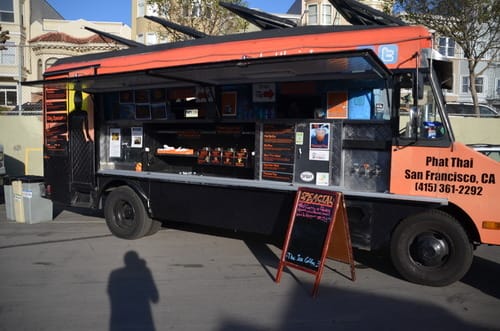Bobby Hossain’s day starts early. Along with his family, he runs a food truck called Phat Thai that serves his mother’s Thai recipes “with a modern twist.” Although he won’t be serving customers for nearly 4 hours, he wakes up by 7:30am. He is working a double shift in the truck (lunch and dinner), so his brother is on prep duty. Bobby buys any last minute supplies they need – ice, more bean sprouts – from Restaurant Depot while his brother cuts vegetables and slices meat at the kitchen space they use in a friend’s restaurant. His brother then drives the truck to their parents’ house. They load up and Bobby is on the road at 9:30.
From 11am-2pm they work at Mission Dispatch – a location in San Francisco’s Mission district that hosts food trucks. It brings in a dependable lunch crowd. Bobby’s mother cooks, his employee Frank takes orders, and Bobby hands out completed orders while helping the other two. After three hours, Phat Thai has served around 200 dishes.
Once the lunch crowd dies down, they return to the commissary, a space where they can clean dishes and dispose of garbage. Bobby checks whether he needs to get more supplies for tomorrow, preps, and then drives the truck to North Beach. From 5pm-8pm they will sell Thai dishes alongside other food trucks at a “market” of food trucks organized by Off The Grid. On busy days, they won’t have a chance to eat lunch.
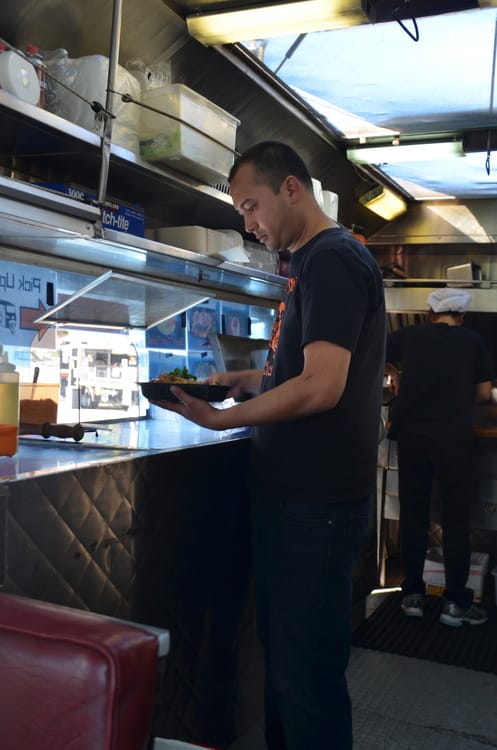
Although it’s only half as busy as lunch, Phat Thai sells dinner to a dense crowd of families and professionals returning from work. By the time they serve their last customer, clean up, and park the truck, it’s approaching midnight. It’s one of Bobby’s busiest days. He and his brother only do double shifts twice a week. Since dinner is less lucrative than lunch, on other days they finish selling food by 3pm and he can get home by 5pm.
Compared to the original American food trucks (a.k.a. roach coaches) that frequented construction sites and baseball stadiums, food trucks like Phat Thai are a different breed. Instead of cheap, greasy fare, they sell $10 dishes featuring organic ingredients and fusions of different regional cuisines. Since their emergence as a social media sensation in 2008, they have asserted themselves as a force in the food scene, employing celebrated chefs and inspiring countless food reviews.
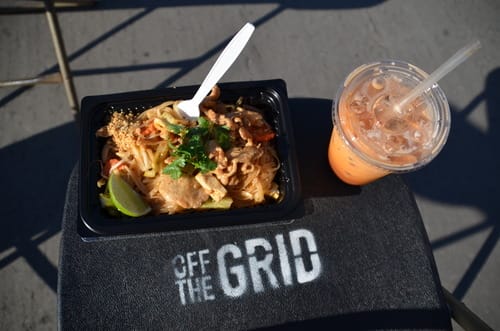
As a service that strips all the overhead costs of a restaurant down to the minimum requirements for selling food to customers, food trucks are also an irresistible metaphor for lean startups: the Silicon Valley practice of quickly rolling out a minimum viable product, allowing customers to try it, and engaging with them to improve your offering. Just as the falling cost of creating a website or app lowered the barriers to entry in the tech industry, food trucks allow aspiring restauranters to quickly put their creations in front of customers with minimal financial barriers.
But given that starting a restaurant is essentially a respectable way to throw money down a hole, are food trucks just mini money pits? What does it take to start and run a food truck? Why is a sandwich in a paper tray $10? Will food trucks disrupt the restaurant industry or is there a bubble?
A Truck of One’s Own
Bobby previously owned a Thai restaurant with his family, but they shut it down in favor of a food truck. “The restaurant business sucks,” Bobby told us bluntly. Unless you’re a restaurant with investors and a flashy concept, it’s nearly impossible to get traction. The rent of their restaurant was $4,500 a month. With their daily customers numbering from 200 to as few as a few, they hemorrhaged money too quickly to build up a customer base. Comparing the rent of the restaurant to the “rent” of attending events like Off The Grid ($50 plus 10% of your revenue), the decision to switch to a food truck was a relatively easy one.
“There’s no rent control on restaurant rent, so even if we did start to be successful, the landlord could jack up our rent. A lot of restaurants get taken advantage of by landlords this way.”
His story is not unusual. The majority of San Francisco’s food truck owners have a background in the industry.
Thomas of We Sushi worked in the restaurant business for twelve years, including two at his own restaurant in Sacramento. Kenny of the Old World Food Truck had 14 years of restaurant experience before starting his truck. Pelle of Nordic With A Twist complements his catering business with his food truck – for the fun of it more than the additional revenue stream. Dawn, along with her co-founders of Me So Hungry, were the exception. They worked as DJs and promoters before opening their truck.
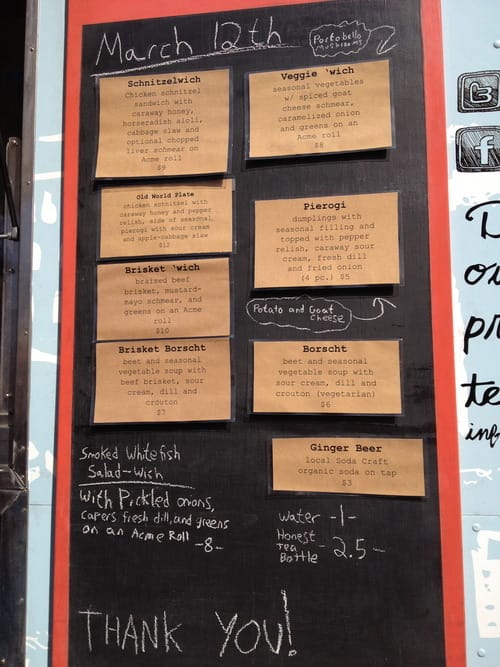
The menu of Kenny’s Old World Food Truck
By far the most common reason we heard from chefs for opening a truck was the desire to start their own business.
The restaurant business is notoriously difficult and expensive to enter. Twenty-five percent fail in their first year and 60% in their first 3 years, according to one well-cited study. And while summing up the cost of a new restaurant is about as exact as giving a figure for a new house, over a quarter of a million dollars is normal. One industry survey calculated the average cost of creating a new concept restaurant at $501,236 and the cost of taking over an existing one at $281,128.
Setting up a food truck is quicker, cheaper, and less risky, making it an easier business for chefs to break into. Josh, the Communications Director at SOMA StrEAT Food Park, stressed how the lower barriers to entry enable minority, low-income, and immigrant chefs to start their own business.
Startup Costs
The food truck market may be easier to break into than the restaurant business, but it is still a major endeavor. The cost of starting a high quality food truck ranges from approximately $50,000 to $150,000 or more, and the process takes several months.
The biggest cost is the truck itself. Bobby’s family bought their truck used for $37,000. Pelle, the caterer who sells Nordic dishes like meatballs, mashed potatoes, and lingonberries, paid $20,000 for his used truck and another $27,000 to outfit it. But trucks looking to tap into the foodie scenes of LA, New York, and San Francisco may need to make a big investment in a custom truck. To meet the challenge of cooking quality sushi, Thomas of We Sushi spent over $100,000 on a custom truck. But so did Me So Hungry, a truck that dishes out creative sliders.
Trucks can be rented to reduce capital costs, but Bobby dismissed the possibility as the rates are almost as high as buying a used truck. Given the healthy market for used trucks, buying one is less of a risk.
The other major start up expense is licensing and permits. Josh of StrEAT Food Park estimates the total cost at up to $10,000, a figure confirmed by several trucks. The various required licenses include a business license, food handler certification, health certification, and fire certification.
Many licenses are administered by the county or city, so a truck that wants to freely roam from the South Bay, north up to San Francisco, and east across the bridge to Oakland and Berkeley would need to clear the permitting and license requirements of at least 4 counties – an expense some but not all trucks undertake.
Today, food truck owners benefit from infrastructure that makes it easier and cheaper to get started and find customers.
Food truck owners cannot run the business out of their house. They are legally obligated to prep food in a certified kitchen and dump used “gray” water in a certified space. Commissaries, kitchens that rent out space to food entrepreneurs, have begun catering to food trucks, offering places to park and re-charge the trucks in addition to cooking facilities.
Organizations like Off The Grid and SOMA StrEAT Food Park offer trucks easy access to customers. Since the reputation and stability of the organizers draws a crowd, trucks can sell to many customers from day one. The pioneers of the food truck world, who established the norm of following trucks on Twitter and searching out their social media presence, also makes it easier for trucks to market themselves.
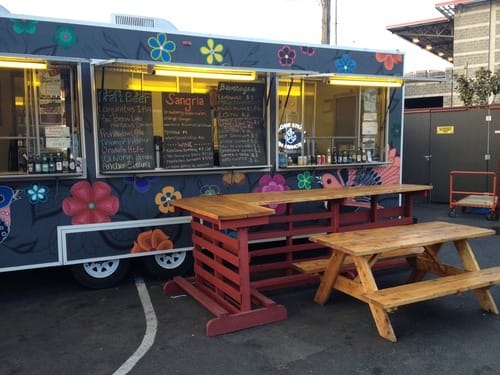
SOMA Street Food Park’s permanent location means they can inject a bar and nightlife into the food truck scene
A number of resources and companies now also streamline the initial process. Off The Grid, for example, offers a comprehensive “Instruktional” guide on how to start a mobile food business for around $300. Some commissaries, like La Cocina, act as incubators for trucks and other food entrepreneurs, offering advice as well as space. We also spied “Mobi Munch,” the name of a company offering a streamlined process of renting a ready-to-go truck, helping with menus and branding, and accessing profitable locations, on the side of several trucks.
The owners we spoke to averaged 2 months of effort until they served their first customer. The maximum we heard was 6 months from a recent group new to the restaurant business. While starting a food truck is a commitment like any small businesses, the total price tag, which can be under $100,000, is relatively modest. For entrepreneurs like Bobby and his family, who paid $70,000 in startup costs, that means that the venture can be financed with personal savings.
Necessity Meets Opportunity
The modern food truck has a founding narrative rooted in the Great Recession and the emergence of social media.
The popping of America’s housing bubble in 2007-2008 meant a stall in new construction projects, leaving food trucks without their best customers. Suddenly, hundreds of used food trucks were for sale. Simultaneously, the recession left many chefs unemployed and potential resteraunters nervous about the risk of opening a restaurant.
Entrepreneurial chefs bought food trucks and began selling their creations on the streets. Thanks to Facebook and Twitter, they could easily reach out to customers and publicize their daily schedules and offerings. A creative cooking culture developed to lure foodies to food trucks. It became a media sensation, captured in social media as well as television series like the Food Network’s Great Food Truck Race.
By 2012, the food truck market was estimated to bring in $1 billion in annual revenue. But the conditions that fueled the industry’s rapid growth are at risk.
Some are market driven. Bobby noted that the price of a used truck had doubled since he bought his a year ago, and found the $180,000 sticker tag of new trucks to be taking advantage of the food truck buzz. The cost of permits has also been raised several thousand dollars. Together, this doubles the startup costs of a food truck.
But the obstacles that most threaten the industry are regulatory. In 2008, gourmet food trucks dealt with regulations designed for small numbers of trucks operating with low visibility. No cap on their numbers existed. They earned certifications and accessed popular spaces fairly easily.
As the trucks’ presence increased in dense urban areas, and local governments faced the ire of restaurants decrying their loss of business to food trucks (which is unfair, in their eyes, as trucks keep costs low by selling on public land) and residents who dislike their presence, regulations have become more onerous and some caps instituted. A food truck applying for a permit in Chicago today, Bobby noted, will receive one in 8 years. Many trucks avoid the permitting process for street parking entirely, and sell exclusively at private functions and marketplaces like Off The Grid. But long waits for other licenses are unavoidable.
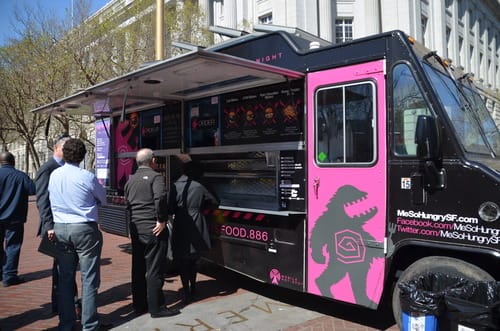
Customers wait in line for Me So Hungry’s sliders
These changes have happened quickly. “A year is equal to 10 food truck years,” Bobby told us. Food trucks are uniting to fight the changes, and the efforts of companies like Off The Grid to secure space and permits for trucks is a great help. But just as startups like Uber that compete with cabs could be undone by regulation protecting the cab companies, restaurant-centric rules could curtail the delicious, grease-fueled growth of America’s food trucks.
Ongoing Costs
The costs of running a food truck are relatively modest compared to a restaurant. Phat Thai is mostly a family affair, with only one employee from outside the family. The main expenses outside of labor are $1,000 a week for food and supplies, $200 of insurance, and $120 to fill up the truck’s enormous tank. Its engine is the same one that powered Camaros in the seventies, but even at its terrible gas mileage, a tanks suffices for the week. Bobby’s family borrows kitchen space in a friend’s restaurant, but commissaries complete with a kitchen, waste disposal, and a parking space run up to $1,000 a month.
If Phat Thai instead paid each employee a fully loaded $1,000 a week (including the three family members, and discounting the occasional work of other relatives) and rented commissary space, their weekly costs would come out to around $5,500. At $10 a meal, working five days a week, they need to sell slightly over 100 meals a day to break even. The day we spoke to them, they had sold over 200 meals during lunch alone. For Phat Thai at least, it’s a much more manageable business model than a traditional restaurant.
Another expense, for trucks that sell at places like Off The Grid, is the cut they owe to the organizers. Off The Grid charges 10% – something of an industry standard. They also expect vendors to sell a minimum of $1,000 of product over the course of a lunch or dinner period. So if a truck sells with them for lunch and dinner, 5 days a week, they will pay the organizer a minimum of $1,000 per week.
It takes practice to purchase the right amount of food and not let any go to waste. Otherwise, there are few variables to a truck’s costs. Success results from great food and solid branding and marketing. The key is to not be that one food truck on the lot without a line of hungry customers.
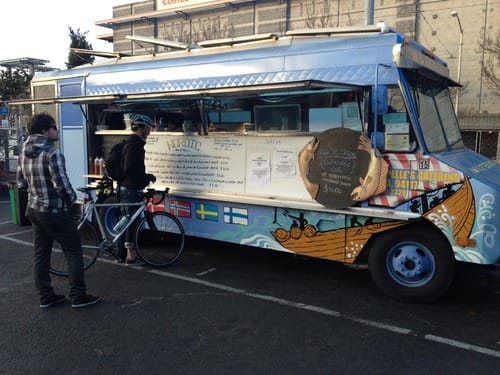
Chef Pelle’s Nordic With A Twist truck
An Unsaturated Market
No one has good data on how many food trucks “make it.” Staff at Off The Grid and the SOMA StrEAT Food Park perceive the failure rate of trucks as lower than in the restaurant business. They think that the low costs of the industry allow even relatively unsuccessful trucks to scrape by. Bobby, however, feels that trucks either succeed or fail. Of the 3 trucks that started at the same time as his, 2 have failed.
Nevertheless, the consensus seems to be that there is room for growth. According to Josh, who worked a food truck before joining SOMA StrEAT Food Park, which has rapidly grown its customer base over its first 9 months:
“There is more demand from customers for food trucks than there is supply. The market is not saturated yet like with restaurants. Eventually it will be, but for now demand is huge.”
Portland, which may have the biggest food truck scene (at least proportional to its size) with over 20 hubs or “pods” where food trucks gather, may offer a glimpse of the natural limits of a food truck scene. Writers report trucks quickly popping up and disappearing. So while the food truck scene in places like San Francisco has room for new vendors, it will be harder to enter the business in the future when demand has been met.
In San Francisco at least, people in the business still feel like they are part of a burgeoning scene. Dawn, from Me So Hungry, left the music scene for food trucks to be part of something new. Josh described the best part of his job as “Being part of this as it grows” and “Seeing food we haven’t seen before.”
Street Food Culture
While past food trucks focused on bringing cheap food directly to customers, the scene that made food trucks trendy is based around experimental cuisine and the social aspect of street food.
Surveying customers at Off The Grid, we met exactly zero who cited cost as a reason to grab lunch from a food truck. A full meal averages $8 to $12. Even desserts or snacks commonly cost $3-$5. Many cited the convenience of food trucks as a draw (they had ambled over from offices across the street), but just as many cited the variety, the quality of the food, and a desire to enjoy San Francisco culture.
In the high-risk world of restaurants, menus rarely change. But from the start in 2008, food trucks took advantage of the freedom of owning a truck to experiment. Rather than advertise a few dollar discount for tracking down a truck, they marketed the novelty of their creations and lured customers with the promise of fancy food at the price of a modest restaurant. So while prices certainly aren’t cheap, customers can take comfort in the fact that vendors charge around $3 less for their dishes than they would in a restaurant. SOMA StrEat Food sees lots of fusion, and the ability of immigrant and minority owners to enter the game adds to the diversity of food as they cook up their family cuisines.
Off The Grid cites an “asian night market,” where street food brings neighbors and friends together in India, China, and Southeast Asia, as their inspiration. At their markets, they bring out chairs, play music, or put on live performances to make the market a community event. A number of the chefs we met cited the social aspect of running a truck – sharing their dishes, meeting different clientele every day, and seeing people actually follow their truck location to location – as their favorite part of owning a truck.
A Stepping Stone, Or the Future?
“To make good money, you need a liquor license.”
All the chefs we met agreed: to make good money in the restaurant business, you have to sell alcohol. On average, it accounts for an estimated 30% or more of a restaurant’s revenue at very high profit margins. Pricing drinks at 80% profit margins is the norm; markups of more than 100% are not uncommon for bottles of wine.
A food truck has been granted a liquor license in New York City, but only because it is actually immobile. Food trucks simply will not be granted a liquor license. What does this mean for food trucks? We encountered two distinct camps that answered that question very differently.
The first camp sees food trucks as a stepping stone. They own a truck because it is easier to start than a restaurant, and they very much enjoy their trucks. But given the inconsistency of selling from a truck (bad weather can cut sales in half and around 75% of all revenue needs to be brought in during the peak season from April to October) and the reality of needing to sell alcohol to make money, they want to build on the success of their food truck to open a restaurant. Our sample size is small, but everyone in this camp said that they were still working their way up to a healthy level of profitability, but weren’t quite there yet.
The second camp, in which Phat Thai plants its flag, views food trucks as the more profitable venture. If restaurants only make money from alcohol, why bother? They make good money from their truck – more even than they would in a restaurant. Bobby would still like to have a restaurant in order to have a permanent location that serves as “advertising” for the truck. (Or, in the future: trucks.) Another owner desired a restaurant to compensate for the inconsistency of food trucks. The owners in this camp described their trucks as profitable and recouping their investment.

What story do the numbers tell? Both, one could argue. While no one is getting Google-IPO rich from the food truck business, many trucks are profitable small businesses.
One truck owner still working his way up to profitability told us that to earn an owner a good salary, a truck would need to bring in upwards of $500,000 of revenue a year. Bobby confirmed this amount, describing $200,000 as an approximate break even point, the equivalent of “just making it into the major leagues.” Half a million per truck is doing quite well and a million dollars of revenue per year around the maximum for a single truck.
Many food trucks are hitting these numbers. Looking around at the surrounding food trucks, Bobby could confidently say that at least 50% had more than $200,000 in annual revenue. And any truck consistently meeting Off The Grid’s minimum earning requirement of $1,000 per 3 hour lunch or dinner session is likely profitable. A truck earning the minimum at 5 lunches a week sums to $240,000 in annual revenue, or $216,000 when you subtract Off The Grid’s Cut. Bobby cited $2,000 as his average take per lunch session.
Food trucks also complement their schedules with more lucrative catering gigs. According to Off The Grid staff, a standard model for a food truck is to do ⅓ of their business at events like Off The Grid, ⅓ at catering events, and ⅓ at street locations that they independently secure. Similarly, SOMA StrEAT Food Park rents out their property for private events. Food trucks catering weddings is now commonplace in San Francisco.
To scale a food truck business, you need more trucks or to expand into catering or a permanent restaurant. Rather than choose between a restaurant or food truck strategy, however, the model seems to be to do both. Curry Up Now, for example, expanded from a food truck to a fleet of food trucks, a catering business, and two restaurants.
In researching this story, it was fun to learn about the economics of food trucks, but more fun to taste the food. Bites of Me So Hungry’s Flyin’ Hawaiin Sliders and Phat Thai’s pad thai remind us that chefs have more on their mind than profit margins. As Josh from the StrEAT Park told us, “You don’t get rich owning a food truck. But no one enters the food business to get rich. You do it because you’re passionate about the food.”
The Future of Food Trucks
The food truck was a creative response to particular economic conditions and an absence of government regulations preventing their formation. The confluence of these factors meant that the cost of creating a food business was lower than ever before. As a result, thousands of food trucks flourished and created a new model.
Food trucks can launch fast and cheap, instantly get customer feedback, and iterate quickly to improve their product. Restaurants can’t do any of this.
But what is the future of food trucks? At some point, there will be enough new entrants to the market that the profits will be competed away and the market will be saturated. Or perhaps local governments will start to heavily regulate food truck permits like they do taxi medallions and liquor licenses. Already, we’re seeing evidence of each of these trends that might curb the food truck movement.
For now though, the food truck business model appears to be sound, entrepreneurs are getting to start successful companies, and the food is NOM NOM NOM. What’s not to like?
This post was written by Alex Mayyasi. He happily resides 100 yards away from Off The Grid’s Upper Haight location. Follow him on Twitter here or Google.




